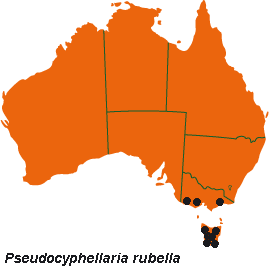



Australian Biological Resources Study
| Checklist of the Lichens of Australia and its Island Territories | ||
| Introduction | A–D | E–O | P–R | S–Z | Oceanic Islands | References | ||
| Pseudocyphellaria rubella (Hook.f. & Taylor) D.J.Galloway & P.James | ||
| Lichenologist 12: 302 (1980); Sticta rubella Hook.f. & Taylor, London J. Bot. 3: 649 (1844); Crocodia rubella (Hook.f. & Taylor) Trevis., Lichenotheca Veneta 75 (1869); Lobaria rubella (Hook.f. & Taylor) Kuntze, Revis. Gen. Pl. 2: 876 (1891). T: St Patricks River, Van Diemens Land, [Tas.], R.C.Gunn; lecto: BM, fide D.J.Galloway & P.James, Lichenologist 12: 302 (1980); isolecto: FH. ***** Parmosticta purpurascens Stirt., Trans. & Proc. New Zealand Inst. 32: 71 (1900); Sticta purpurascens (Stirt.) Zahlbr., Cat. Lich. Univ. 3: 362 (1925). T:"Blue Fier" [Blue Tier], Tas., F.Mueller; lecto: BM, fide R.W.Rogers, Austrobaileya 1: 507 ('1982') [1983]. | ||
| Thallus rosette-forming to irregular and straggling, closely attached centrally, 5–10 (–15) cm wide. Lobes linear-elongate to irregularly rounded, discrete at margins to imbricate centrally, 1–2 (–5) cm long, 5–15 (–20) mm wide; margins crenate-ragged, incised, torn or ±lobulate, white-tomentose, often eroded yellow-sorediate or with punctiform to linear yellow pseudocyphellae, slightly thickened below. Upper surface pale greenish grey to pinkish buff when dry (becoming reddish in part on long storage), lettuce-green to olive-green when wet, undulate, shallowly wrinkled to faveolate in parts, occasionally fenestrate or reticulate-cracked, white-silky-tomentose throughout; without maculae, isidia, phyllidia or pseudocyphellae. Soredia in marginal linear or discrete labriform soralia, or in scattered erose laminal soralia, coarse, granular, yellow, often covering large areas of thallus. Medulla yellow. Photobiont green. Lower surface pale yellow-white, darkening centrally, minutely pubescent to densely tomentose. Pseudocyphellae prominent, numerous, yellow. Apothecia rare, submarginal, pedicellate, 1–6 mm diam.; disc dark red-brown to brown-black, epruinose; exciple concolorous with thallus, coarsely corrugate-scabrid, with scattered pustular yellow marginal soralia; epithecium dark olive-grey to brown; hymenium colourless; hypothecium opaque, red-brown. Ascospores ellipsoidal, 3-septate, 25–35 (–38.5) × 9–11 µm, brown. CHEMISTRY: Pulvinic acid, pulvinic dilactone, calycin and 20 lupane triterpenoids, viz. 3β-acetoxylupan-29-al, 3β-acetoxylupan-2-ol, (29RS)-3β-hydroxylupan-29-al, (20RS)-3β-hydroxylupan-20-oic acid, (20RS)-3β-acetoxylupan-20-oic acid, lupan-3β,20-diol, (20RS)-lupan-3β,20-diol, (20RS)-30-norlupane-3β,20-diol, (20RS)-lupane-3β,20,29-triol, (20RS)-3β-acetoxylupane-20,29-diol, 3β-acetoxylup-20(29)-ene, 3β-acetoxy-30-norlupan-20-one, 3β-acetoxylup-20(29)-en-30-ol, 3β-hydroxy-30-norlupan-20-one, 3β-hydroxylup-20(29)-ene (lupeol), lup-20(29)-en-3β,30-diol, 20,29,30-trinorlupane-3β,19α-diol, 3β,19α-diacetoxy-20,29,30-trinorlupane, 3β-acetoxylupan-20(29)-epoxide and 3β-hydroxylupan-20(29)-epoxide. |  |
|
| Occurs in southern Vic. and Tas.; grows in rainforest canopy or in wet scrub or heath at margins of rainforest. Also in New Zealand. | ||
| Galloway et al. (2001) | ||
| Checklist Index |
| Introduction | A–D | E–O | P–R | S–Z | Oceanic Islands | References |
This work is copyright. Apart from any use as permitted under the Copyright Act 1968, no part may be reproduced by any process without prior written permission from Australian Biological Resources Study. Requests and inquiries concerning reproduction and rights should be addressed in the first instance to Dr P. McCarthy. These pages may not be displayed on, or downloaded to, any other server without the express permission of ABRS.